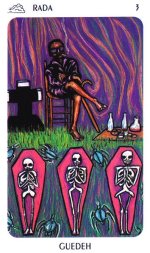afrosaxon
The 3 Rada card in the New Orleans Voodoo Tarot is different from the traditional 3 of Swords in a RWS deck.
http://alpha.mxat.ru/WWPCM/decks05/d02446/d02446s3.jpg
For starters, there are no bleeding hearts or swords. The Rada nation is the more benign and positively regarded within the voudoun pantheon.
This card shows Guedeh camping out in a cemetery. He sits beside a tombstone shaped as a cross, and on his other side is an array of foods and beverages left as an offering to him. The vessels in the offering could even be the sacred govi (clay jars that hold the spiritual essences of the dead) of the three skeletons he oversees. Guedeh smokes and seems very relaxed...as he should, since he is the spirit of Death (not the dead, but Death itself). This Guedeh may actually be a representative of the three most-honored Barons: Baron Guedehs: Baron Samedi (who carries a cane); Baron La Croix (represented by the cross tombstone) and Baron Cimitiere (who is often depicted carrying a tombstone, which represents the cemetery).
The bones in the coffin are in repose and -- dare I say -- seem to be grinning? Their hands are positioned as if in prayer. The brightly colored coffins definitely seem to add some festivity to the atmosphere of death. Indeed, the entire card is full of color -- not what one would expect in the traditionally negative RWS depiction of the 3 of Swords. The purple background seems to be a nod to the psychic realm, and there is movement among this purple (spirits?).
Their hands are positioned as if in prayer. The brightly colored coffins definitely seem to add some festivity to the atmosphere of death. Indeed, the entire card is full of color -- not what one would expect in the traditionally negative RWS depiction of the 3 of Swords. The purple background seems to be a nod to the psychic realm, and there is movement among this purple (spirits?).
Among the coffins crawl beetles...these beetles look to be the Egyptian scarab, which have long been associated with resurrection, transformation, and renewal. The grass among the coffins is green and seems to be growing quite well.
In this deck, I don't take this card as a symbol of heartbreak, loss, and sadness (or, the dreaded "other woman/man" connotation). Instead, it seems to speak to life after death, in a sense. Not in the traditional "Judgment" sense (e.g., The Rapture/Second Coming of Christ), but in the sense that death is but a transformation, a step toward a new path, a new journey. The card refers to the joy that comes from the release of the burdens of the old (via death -- the old has died) and embracing the new...like how beautiful plants grow from fertilizer, especially dung or manure (which are waste products).
Thoughts?
T.
http://alpha.mxat.ru/WWPCM/decks05/d02446/d02446s3.jpg
For starters, there are no bleeding hearts or swords. The Rada nation is the more benign and positively regarded within the voudoun pantheon.
This card shows Guedeh camping out in a cemetery. He sits beside a tombstone shaped as a cross, and on his other side is an array of foods and beverages left as an offering to him. The vessels in the offering could even be the sacred govi (clay jars that hold the spiritual essences of the dead) of the three skeletons he oversees. Guedeh smokes and seems very relaxed...as he should, since he is the spirit of Death (not the dead, but Death itself). This Guedeh may actually be a representative of the three most-honored Barons: Baron Guedehs: Baron Samedi (who carries a cane); Baron La Croix (represented by the cross tombstone) and Baron Cimitiere (who is often depicted carrying a tombstone, which represents the cemetery).
The bones in the coffin are in repose and -- dare I say -- seem to be grinning?
Among the coffins crawl beetles...these beetles look to be the Egyptian scarab, which have long been associated with resurrection, transformation, and renewal. The grass among the coffins is green and seems to be growing quite well.
In this deck, I don't take this card as a symbol of heartbreak, loss, and sadness (or, the dreaded "other woman/man" connotation). Instead, it seems to speak to life after death, in a sense. Not in the traditional "Judgment" sense (e.g., The Rapture/Second Coming of Christ), but in the sense that death is but a transformation, a step toward a new path, a new journey. The card refers to the joy that comes from the release of the burdens of the old (via death -- the old has died) and embracing the new...like how beautiful plants grow from fertilizer, especially dung or manure (which are waste products).
Thoughts?
T.


